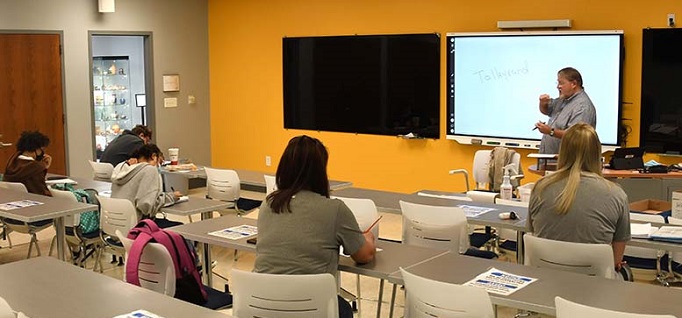Bridging the broadband divide
By Barbara Shelly
March 31, 2021
North Carolina community colleges make investments to expand broadband access for students.
On a spring weekend in 2020, Gregory McLeod went to his office on a Sunday to catch up on work and reflect on the many changes the coronavirus pandemic had brought to Edgecombe Community College (ECC) in North Carolina, where he is president.
McLeod was taking a stroll around the empty campus when he was surprised to encounter a student. The young man was sitting in a lawn chair by a locked door of a building. He’d brought a portable table and his laptop, which he plugged into an outdoor electrical outlet. He needed to study, he explained, and he didn’t have reliable internet service at home.
“I was proud of him, but I was also sad,” McLeod said. “I wished we could have accommodated him better.”
McLeod knew before the pandemic that many of his students lack digital access. More than a third of households in Edgecombe County have no broadband subscription, according to U.S Census data. The library and computer rooms at ECC were always crowded with students using the school’s network.
Lockdowns initiated to stop the spread of Covid cut off access to those resources at the same time it forced students and teachers to go online for classes. Coffee shops, libraries and other places where students would go for reliable internet were also suddenly off limits.
“It did force us to ask, ‘What can we do? What more can we open up?’” McLeod said.
Not a unique situation
Edgecombe County’s situation is not unusual. While cities such as Charlotte and Raleigh are tech hubs, the state’s broadband infrastructure office estimates that 640,000 people are without internet service. Most of them live in sparsely populated areas, like Edgecombe County in the northeast part of the state. And North Carolina’s broadband deployment rate is above the national average, meaning other states face even greater struggles in connecting citizens at home.
Access issues have widened inequities and tested education at every level in the pandemic, with the community college sector taking a hard hit. Its overall fall semester enrollment was down 10% nationwide. Nearly one in five students said they either didn’t enroll or stopped taking classes because they lacked the technology and internet access to participate online, according to survey by New America.
“I think colleges have found that their students are way less connected to high speed internet than maybe we had thought they were,” said Iris Palmer, senior adviser for higher education at New America.
After lockdowns began, colleges figured out how to distribute laptops and mobile hotspots to students, Palmer said, only to discover they had no way to use them in homes that lack broadband or even reliable cell service.
“They thought students would have access to a Zoom call at home, and that is just not the case,” she said.
Tapping federal relief funding
In North Carolina, the state’s community college system launched a “rural college broadband access project,” using $12 million in federal coronavirus relief funds to make reliable internet service widely available on 20 of its rural campuses.
“This was an effort to ensure there was access in those communities that may not have broadband other than at the community college,” said Thomas Stith, the system president. “It provided access in some of our most fragile communities.”
Lenoir Community College (LCC), in east North Carolina, used its funds to strengthen its fiber network across its main campus and add 10 outdoor access points. Community college and high school students are invited to use the school’s wifi for their studies.
“We knew we were going to have a larger demand, so what we did, we really improved our infrastructure,” said LCC President Rusty Hunt. “Now our entire campus is saturated so folks can get a pretty reliable signal that’s going to help them to do their classes. If they want to come at night and sit in the parking lot and work, they can do that.”
LCC also invested in smart boards and other technology for synchronous learning – meaning classes that can be accessed in a classroom or online from anywhere.
“It not only addressed the pandemic, it addressed issues we’ve had in community colleges for years,” Hunt said. “Many of our students are working, or they’ve got kids at home, or both. Sometimes they just can’t fit classes into their schedule. This synchronous learning gives those folks an opportunity not to have to miss instruction. Going forward, I think this will continue to expand.”
There’s more to the story! Read the full article in CC Daily.



